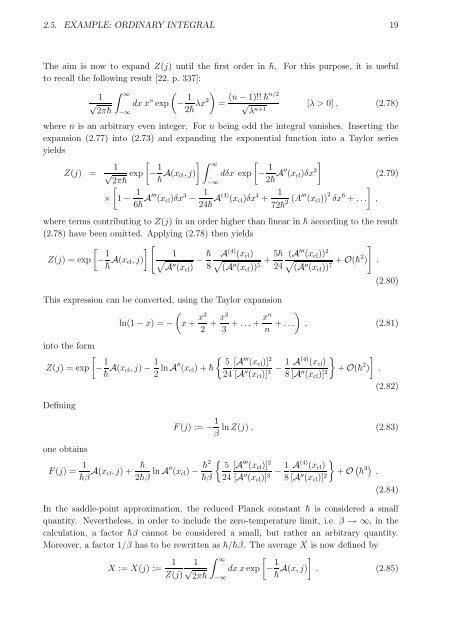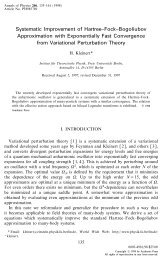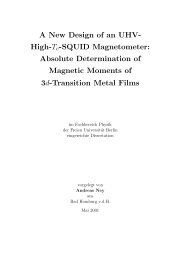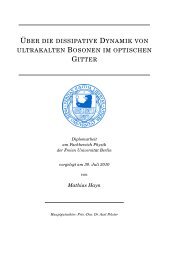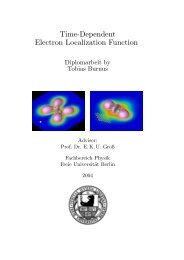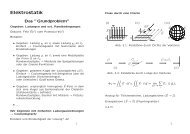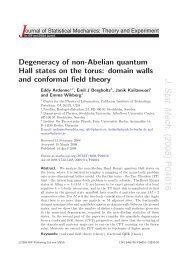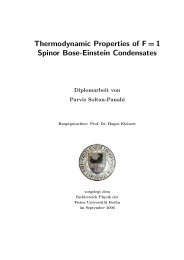Diploma thesis - Fachbereich Physik
Diploma thesis - Fachbereich Physik
Diploma thesis - Fachbereich Physik
You also want an ePaper? Increase the reach of your titles
YUMPU automatically turns print PDFs into web optimized ePapers that Google loves.
2.5. EXAMPLE: ORDINARY INTEGRAL 19<br />
The aim is now to expand Z(j) until the first order in ¯h. For this purpose, it is useful<br />
to recall the following result [22, p. 337]:<br />
∫<br />
1 ∞<br />
(<br />
√ dx x n exp − 1 )<br />
(n − 1)!! ¯hn/2<br />
2π¯h 2¯h λx2 = √ [λ > 0] , (2.78)<br />
λ<br />
n+1<br />
−∞<br />
where n is an arbitrary even integer. For n being odd the integral vanishes. Inserting the<br />
expansion (2.77) into (2.73) and expanding the exponential function into a Taylor series<br />
yields<br />
Z(j) =<br />
1<br />
√ exp<br />
2π¯h<br />
×<br />
[<br />
− 1¯h ]∫ ∞<br />
[<br />
A(x cl, j) dδx exp − 1 ]<br />
−∞ 2¯h A′′ (x cl )δx 2<br />
[<br />
1 − 1<br />
6¯h A′′′ (x cl )δx 3 − 1<br />
24¯h A(4) (x cl )δx 4 + 1<br />
72¯h 2 (A′′′ (x cl )) 2 δx 6 + . . .<br />
]<br />
(2.79)<br />
where terms contributing to Z(j) in an order higher than linear in ¯h according to the result<br />
(2.78) have been omitted. Applying (2.78) then yields<br />
[<br />
Z(j) = exp − 1¯h ] [ ]<br />
A(x 1<br />
cl, j) √<br />
A<br />
′′<br />
(x cl ) − ¯h A (4) (x cl )<br />
√<br />
8 (A<br />
′′<br />
(x cl )) + 5¯h (A ′′′ (x cl )) 2<br />
√ 5 24 (A<br />
′′<br />
(x cl )) + 7 O(¯h2 ) .<br />
,<br />
(2.80)<br />
This expression can be converted, using the Taylor expansion<br />
)<br />
ln(1 − x) = −<br />
(x + x2<br />
2 + x3<br />
3 + . . . + xn<br />
n + . . . , (2.81)<br />
into the form<br />
Z(j) = exp<br />
Defining<br />
one obtains<br />
[<br />
− 1¯h A(x cl, j) − 1 2 ln A′′ (x cl ) + ¯h<br />
{ 5 [A ′′′ (x cl )] 2<br />
24 [A ′′ (x cl )] − 1 }<br />
A (4) (x cl )<br />
3 8 [A ′′ (x cl )] 2<br />
]<br />
+ O(¯h 2 )<br />
.<br />
(2.82)<br />
F(j) := − 1 ln Z(j) , (2.83)<br />
β<br />
F(j) = 1<br />
¯hβ A(x cl, j) + ¯h<br />
{<br />
2¯hβ ln A′′ (x cl ) − ¯h2 5 [A ′′′ (x cl )] 2<br />
¯hβ 24 [A ′′ (x cl )] − 1 3 8<br />
}<br />
A (4) (x cl )<br />
+ O (¯h 3) .<br />
[A ′′ (x cl )] 2<br />
(2.84)<br />
In the saddle-point approximation, the reduced Planck constant ¯h is considered a small<br />
quantity. Nevertheless, in order to include the zero-temperature limit, i.e. β → ∞, in the<br />
calculation, a factor ¯hβ cannot be considered a small, but rather an arbitrary quantity.<br />
Moreover, a factor 1/β has to be rewritten as ¯h/¯hβ. The average X is now defined by<br />
X := X(j) := 1 ∫<br />
1 ∞<br />
√ dx x exp<br />
[− 1¯h ]<br />
Z(j)<br />
A(x, j) . (2.85)<br />
2π¯h<br />
−∞


